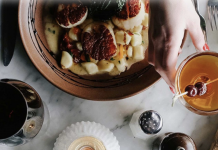“Are you gonna eat your fat?”
-Spalding, from the movie Caddyshack
Have you ever cooked a roast and found a layer of fat left in the pan? Or made a pot of chili and skimmed fat from the surface?
Instead of tossing the fat by-products from a roast or stew, use them in your next meal to add flavor. These fats might not be glamorous, but they can add flavor to more vegetable-based meals. The addition of a small amount of meat flavor can make a subtle, but significant difference in a meal where meat might otherwise be absent.
If you’re like many Americans and trying to eat more vegetable-based meals, using meat as an accent flavor can make them more satisfying. I keep little tubs of reserved fats in my fridge and pull them out as a secret flavor weapon. When my family asks how I made a simple dinner taste so good, I shrug my shoulders and tell them if they want to know they should hang out in the kitchen more often during dinner-making time.
Some potential ways to use reserved fats:
 1. Soups and stews
1. Soups and stews
Slowly cook aromatic vegetables and herbs, such as onion, garlic, celery, tomatoes, bell peppers, thyme, sage, and oregano, in any combination in the reserved fats. Cook them on low heat until they are thick and flavorful, but not browned. For those of you familiar with Italian, Spanish or Caribbean cooking, you’ll recognize this flavor base as soffrito. Use this base with water to start all kinds of otherwise vegetarian soups and stews. Use starches like potatoes, pasta or grains to add more body.
2. Rice and grains
Add flavor and soft texture to rice and grains with reserved fats. Sweat onions in the fat until softened. Then add the grains and stir, coating them in the fat. Season with salt and pepper or try spices and herbs as well. Add tomato paste or chopped tomato for more flavor, color, and body. Finish by adding the correct amount of water for the grain being used and cover, cooking until the grains are plump and fully cooked.
 3. Roast vegetables
3. Roast vegetables
Loosen the reserved fats in a warm pan and mix them with some vegetable fat or olive oil. Toss the warmed fat with large diced vegetables, coating them well as if you were tossing a salad. Season the vegetables with salt and pepper. Roast the vegetables in an extremely hot oven, tossing them in the pan midway through the cooking, and cook until tender and browned. Almost any vegetable will work, but I like cauliflower, eggplant, mushrooms, Brussels sprouts, peppers and onions, winter squash, summer squash, and asparagus.
4. Vinaigrettes for salads
Reserved fats make great warm vinaigrettes when used sparingly and mixed with vegetable or olive oil. Sweat minced shallots in a pan with a mixture of the reserved fat and vegetable or olive oil. Take the pan off the heat and finish with wine vinegar. For a more Asian style, add sliced shitakes to the shallots, then a dash of soy and rice wine vinegar. Or for a spicier sauce, use minced jalapenos and fine-diced tomatoes. Use the vinaigrettes on spinach, hearty greens like escarole, dandelion or kale, blanched and cooled vegetables like cauliflower or broccoli, or starches like Asian noodles or potatoes.
Not everybody likes the idea of using these often trash-bound fats, but in an age where bacon makes everything better, give it a try.






